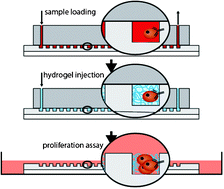Diagnostic microchip to assay 3D colony-growth potential of captured circulating tumor cells
Abstract
Microfluidic technology has been successfully applied to isolate very rare tumor-derived epithelial cells (circulating tumor cells, CTCs) from blood with relatively high yield and purity, opening up exciting prospects for early detection of cancer. However, a major limitation of state-of-the-art CTC-chips is their inability to characterize the behavior and function of captured CTCs, for example to obtain information on proliferative and invasive properties or, ultimately, tumor re-initiating potential. Although CTCs can be efficiently immunostained with markers reporting phenotype or fate (e.g. apoptosis, proliferation), it has not yet been possible to reliably grow captured CTCs over long periods of time and at single cell level. It is challenging to remove CTCs from a microchip after capture, therefore such analyses should ideally be performed directly on-chip. To address this challenge, we merged CTC capture with three-dimensional (3D) tumor cell culture on the same microfluidic platform. PC3 prostate cancer cells were isolated from spiked blood on a transparent PDMS CTC-chip, encapsulated on-chip in a biomimetic hydrogel


 Please wait while we load your content...
Please wait while we load your content...